Fall Issue 2022
From the President
 I hope that you and your family are ready to enjoy the fall breeze and autumn leaves. It’s an ideal time to visit a preserve you haven’t seen, explore a new trail, or enjoy a fall program at one of our education centers. With 26,000 acres of open space in DuPage, you will certainly find something magical this season.
I hope that you and your family are ready to enjoy the fall breeze and autumn leaves. It’s an ideal time to visit a preserve you haven’t seen, explore a new trail, or enjoy a fall program at one of our education centers. With 26,000 acres of open space in DuPage, you will certainly find something magical this season.
This year we’re thrilled to mark the return of Fall Festival at Danada, and instead of one day of fun, we’re expanding the event to two days, Saturday, Oct. 8, and Sunday, Oct. 9. Our largest event, Fall Festival includes equestrian performances, wagon rides, kids activities, great food, and more. Admission and parking are free, and you can find out more about this fun family experience online.
As the seasons change, we continue to be busy. Construction is complete for the new 180-space parking lot at Waterfall Glen, and work has started on the major renovation of the exterior of Mayslake Hall. Our fleet building at Blackwell has a full array of solar panels ready to go online, and the board recently approved the development of a comprehensive clean-energy, resiliency, and sustainability plan, which will help guide our conservation efforts into the future. We also hosted a ceremonial groundbreaking celebration for the new Willowbrook Wildlife Center, a project that will be under construction for the next two years. In the meantime, we’re actively seeking grants and donations for this most-loved wildlife center.
There is so much going on that I encourage you to follow us on our social media sites or sign up for email alerts. Fall is the perfect season to enjoy all of the beautiful sites, colors, and programs we have to offer. See you on the trails!

Daniel Hebreard
President, Forest Preserve District of DuPage County
News & Notes
2023 Annual Permits on Sale Dec. 1

Annual permits for 2023 for private boating, archery, off-leash dog areas, and model crafts go on sale online on Thursday, Dec. 1.
Permits will also be available Monday – Friday 8 a.m. – 4 p.m. through Visitor Services at 630-933-7248 or at Forest Preserve District headquarters at 3S580 Naperville Road in Wheaton.
Questions? Call Visitor Services, or use our convenient online chat at dupageforest.org.
Collections Corner
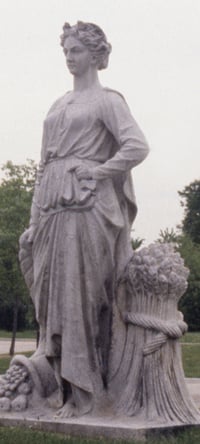
When the Forest Preserve District purchased Hidden Lake in 1978, it also acquired something unexpected: two 12-foot-tall, 5.5-ton statues.
After much research and help from the Chicago Historical Society, the District discovered that the two statues, one posing with a cornucopia symbolizing agriculture and one with an anchor and anvil representing industry, had once graced the second-story ledge of the 1833 Chicago Board of Trade building. The pieces’ origin is unknown, but researchers speculated they were crafted in Italy. When the trade building was razed in 1930, businessman Arthur Cutten preserved the statues, moving them to his Sunny Acres Farms, today’s Hidden Lake.
The statues eventually moved to Danada Forest Preserve, but in 2004 the District returned them to the Board of Trade, where they now stand on display, demonstrating how research and a commitment to discovering the provenance of items are as important as maintaining the pieces that remain in the Forest Preserve District’s collection.
Right: The statue representing agriculture as it stood at Danada Forest Preserve
Live and on Demand

Can’t make it to a board meeting? Find schedules and agendas and watch it live or on demand under “Our Board.” You can also link directly to live streaming video from the Forest Preserve District’s Facebook page at facebook.com/dupageforest.
Commission meetings and planning sessions are open to the public and held at Forest Preserve District headquarters at 3S580 Naperville Road in Wheaton. Normally, commission meetings are at 8 a.m. on the first and third Tuesdays of the month; planning sessions, 8 a.m. on the second and fourth Tuesdays. At both, the board hears public comments and staff reports, discusses business, and votes on agenda items.
Forest Preserve District Celebrates Upcoming Master Plan Projects


Top: (L to R) State Rep. Deanne Mazzochi, Commissioner Linda Painter, President Daniel Hebreard, Commissioner Tina Tyson-Dunne, and State Sen. Suzanne Glowiak Hilton at Mayslake
Bottom: Forest Preserve District commissioners with staff from contractor Wight & Company at the Willowbrook Wildlife Center ceremonial groundbreaking
Forest Preserve District commissioners and staff recently joined forest preserve fans to kick off two major master plan projects.
On July 16, the Forest Preserve District marked the start of a yearlong exterior restoration project at historic Mayslake Hall. The $6.4 million certified master plan project will repair structural deficiencies and other problems with the roof, masonry, wood, stucco, windows, doors, and foundation. A $750,000 capital grant from the Public Museum Capital Grants Program, Illinois Department of Natural Resources, Illinois State Museum will help pay for the renovations.
On Aug. 16, the District also held a ceremonial groundbreaking for an ambitious $25.5 million project for Willowbrook Wildlife Center, which will transform the center and make it the agency’s first net-zero-designed building. The project includes a 27,000-square-foot wildlife rehabilitation clinic and visitor center that will allow visitors to view animals through one-way windows and video monitors as patients are examined, treated, in surgery, being fed, and rehabilitated.
Many Thanks

The Friends of the Forest Preserve District supports the District by inviting individuals, corporations, and foundations to donate for the benefit of natural areas, wildlife, and master-plan projects. We thank the following donors who contributed $500 or more in the second quarter to help enhance our environment and quality of life in DuPage. If you would like to learn more about how you, your group, or your business can partner with us, visit dupageforest.org/friends or call 630-871-6400.
Estate of Beth Fikar
$25,000 — Willowbrook Wildlife Center Master Plan Improvements
Kline Creek Farm Visitors
$5,770 — Kline Creek Farm
Giving DuPage
$5,477 — Willowbrook Wildlife Center
Marilyn L. Schweitzer and Michael Firman
$5,064 — Natural Resources, Willowbrook Wildlife Center, and Education
Jessica Ahn, in memory of Edwin Eunkyu Ahn
$5,000 — Tribute bench
ComEd, an Exelon Company
$2,500 — Willowbrook Wildlife Center
Willowbrook Wildlife Center Visitors
$2,252 — Willowbrook Wildlife Center
Robert and Rosemary Carroll
$2,000 — Mayslake Peabody Estate
Edward and Clare Malysiak, in memory of Holden Wight
$1,030 — Tribute bench
Gregory Baird
$1,000 — Willowbrook Wildlife Center
Palais Charitable Foundation
$1,000 — Willowbrook Wildlife Center
Robert R. McCormick Foundation
$1,000 — Willowbrook Wildlife Center
Mr. David Nienke
$750 — Area of greatest need
J. Lyons
$625 — Area of greatest need
Ace Hardware Corporation
$500 — Native Plant Presale sponsor
Keith and Dorine Bryant
$500 — Area of greatest need
Cathleen Carter
$500 — Willowbrook Wildlife Center
Dawn Chiang
$500 — St. James Farm
The Davey Tree Expert Company
$500 — Native Plant Presale sponsor
Domtar Paper
$500 — Willowbrook Wildlife Center
John and Diane Fiore
$500 — Willowbrook Wildlife Center
Daniel Hebreard and Family
$500 — Native Plant Presale sponsor
Allan G. Hins
$500 — Willowbrook Wildlife Center
Kathleen Isoda
$500 — Willowbrook Wildlife Center
Kathleen Murphy
$500 — Kline Creek Farm
Precision Homes LLC., in memory of Holden Wight
$500 — Tribute bench
Jefferson and Catherine Reiter
$500 — Willowbrook Wildlife Center
Rice Lake Square
$500 — Native Plant Presale sponsor
Schwab Charitable
$500 — Area of greatest need
Chet and Jeanette Wilczak
$500 — Mayslake and St. James Farm
The Return of the River Otter
They’re covered in fur but live in the water. They’re fond of fish and crayfish and sliding in the snow, and ecologists are excited that they’re back again in DuPage County forest preserves. They’re North American river otters, and the story of their return is as interesting as the animals themselves.
Before Europeans arrived in Illinois, river otters lived statewide. But soon after Father Jacques Marquette and fur trapper Louis Jolliet made their way through the area in the late 1600s, fur trading became a big — and unregulated — economic driver for the region, one that lasted well into the mid-1800s. River otters declined drastically, and sightings soon became rare.
To save the otter, Illinois made harvesting illegal in 1929, but although the otter was protected, its habitat was not. There were few environmental regulations in the early to mid 1900s, and once-pristine rivers and lakes became dumping grounds for just about anything cities needed to discharge or flush. It wasn’t until later in the century, when people began to realize how environmental conditions affected human health, that the Environmental Protection Agency was created and the way people looked at native wildlife and natural areas began to change.
In 1977, Illinois listed the river otter as threatened; in 1989, endangered. By then, only about 100 otters lived in the state. The Illinois Department of Natural Resources wanted to boost populations, but budget cuts in the early 1990s prohibited purchasing animals from the state of Louisiana, which had a robust population. A clever and resourceful deal in 1994 helped solve the dilemma. Louisiana captured 50 river otters for release in Illinois. Kentucky paid Louisiana for the otters, and Illinois repaid Kentucky with 75 wild turkeys. Over a three-year period, Illinois released 346 river otters as a result of the arrangement, mostly in southern and central parts of the state. Relatively uninhabited rivers provided uninhibited travel corridors where the otters could spread and recolonize. In 2004, just 10 short years after the first reintroduction, the river otter was removed from the endangered species list in Illinois. Today an estimated 20,000 live throughout the state — some right here in DuPage.
But what exactly are river otters? Well for starters, they’re members of the weasel family, Mustelidae. Notable relatives include weasels, mink, ferrets, badgers, martins, and wolverines. Like mink, though, river otters are aquatic mammals, spending most of their time in the water.
River otters have elongated bodies with flattened heads and streamlined profiles. They weigh 11 to 30 pounds and range from 26 to 42 inches. Their tails can be about a third of their body length and, along with their webbed feet, help their agility when propelling through the water.
Otters’ thick dense coats insulate the skin from the water as well as cold temperatures. Their fur’s waterproofness comes from glands that produce oils the animals distribute throughout their bodies by frequent grooming.
As carnivores, otters dine on fish, crayfish, mussels, frogs, turtles, and snails. Their long whiskers help them locate prey in dark or turbid waters, and their sharp teeth and claws make for easy meals. They will occasionally eat waterfowl, muskrats, beavers, and cottontails, the latter showing they’re capable predators on land as well as in the water.
River otters den in or near the water, typically along the banks of rivers or lakes and sometimes in abandoned beaver or muskrat lodges. Polygamous, otters mate with several partners in their lifetimes. Females give birth to pups in their dens with litters from one to six, although two to three is more common, and will stay with their young in family groups for seven to eight months. The males do not stay with their families but will form social groups with other males that hunt and travel together.
Like most mammals, river otters are active year-round, although they tend to be more nocturnal during spring through fall and more active during the day in winter. On land they walk, run, or bound, but they even slide, which can be more efficient when travelling across snow or ice or down slopes.
When spotted, river otters can be fun to watch in social settings because they often appear to be playful. They like to chase each other on land and in the water while indulging in a slide when an embankment is nearby. These activities may
look like simple play, but they improve hunting skills and strengthen social bonds.
Whenever a species like the river otter recovers, it adds to the biodiversity of the land. After all, each species is unique and has a niche in the ecosystem. Next time you’re near a river, marsh, or lake, scan the area. You might be rewarded with an otter sighting of your own.
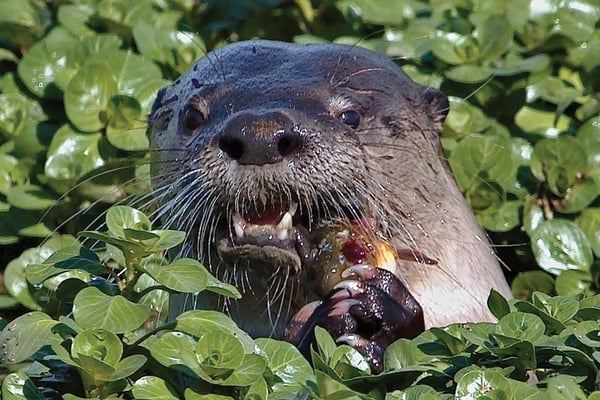

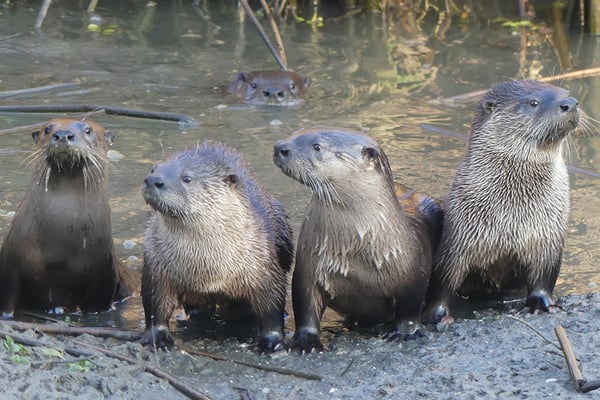
The Inside Story on Galls
As summer fades into autumn, and autumn begins to crisp into winter, we find ourselves slowing down, wrapping up in protective layers of clothing, and relying more on shelters to keep us from the cold. It may be surprising, but many insects are doing the same thing. Instead of thermal layers and heated houses, though, these tiny creatures rely on galls.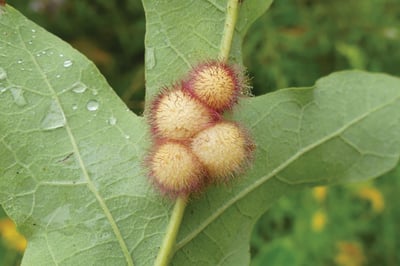
A gall is an abnormal growth on a plant caused by an external stimulus. Fungi, bacteria, nematodes (aka roundworms), and physical injuries can all cause galls, but in most cases, growth is initiated by the presence of insect larvae. In North America about 1,500 species of insects form galls on different plants, and although the exact details vary depending on the insect and the plant, the general process is the same.
In late spring, when plants are actively growing, certain female insects (often types of wasps or midges) deposit eggs into plants’ leaves, buds, stems, or bark. The eggs hatch, and the resulting larvae begin to feed on the plants’ tender tissues. It’s this feeding that triggers a gall to grow. As a larva feeds, the surrounding area fills with an excess of plant growth hormones, resulting in rapid cell division. As the plant’s cells divide and grow, they form thick layers that encase the larva inside.
As fall approaches, this larval growth slows. The developing insect prepares for winter by producing concentrated levels of glycerol, which acts like antifreeze and keeps the larva’s soft body from forming damaging ice crystals. In spring when temperatures rise, the larva resumes development, eventually emerging from the gall as a winged adult, ready to initiate the cycle again.
Galls can be found in forest preserves as well as in backyards on trees, bushes, and flowers. Some can disfigure leaves or stems, but it’s uncommon for them to harm or kill a healthy plant. In fact, the presence of galls in a yard can attract insect predators that provide a natural biological control of the insects making the galls. (If galls are unsightly and affecting the aesthetics of a plant, concerned gardeners can prune back the branches.)
Aside from playing brief yet vital roles in many insects’ life cycles, galls hold an important place in local ecology. Many animals such as birds and mice peck or chew through galls to reach the developing larvae inside as a source of food. After the adults exit, the empty gall structures provide shelter for different insects and other tiny animals. Plus, galls are fun to find, interesting to look at, and a good way to draw people of all ages into the joys of observing nature.
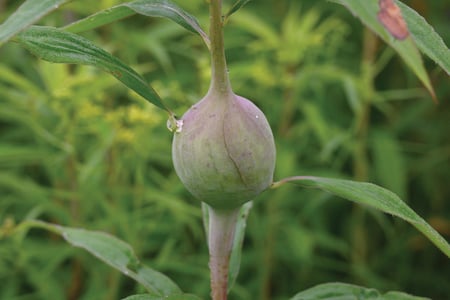 In any case, fall in DuPage forest preserves is a good time to keep an eye out for different types of galls. Goldenrod is a common fall flower and the host plant to several gall-forming insects. The aptly named goldenrod gall fly and goldenrod gall moth both lay their eggs in the stems of goldenrod plants. The resulting galls are either smooth and spherical (ball galls) or shaped like elongated footballs (elliptical galls) and are easy to spot. The larvae overwinter in the stems and emerge the following spring.
In any case, fall in DuPage forest preserves is a good time to keep an eye out for different types of galls. Goldenrod is a common fall flower and the host plant to several gall-forming insects. The aptly named goldenrod gall fly and goldenrod gall moth both lay their eggs in the stems of goldenrod plants. The resulting galls are either smooth and spherical (ball galls) or shaped like elongated footballs (elliptical galls) and are easy to spot. The larvae overwinter in the stems and emerge the following spring.
There are also several species of midges (types of flies) that form “bunch” galls on goldenrods by laying their eggs in undeveloped leaf buds. This causes the affected stems to alter their development and grow dense clusters of leaves where the eggs were laid. The leafy rosettes are often mistaken for blooms, and thus bunch galls are sometimes known as a flower galls.
Oak trees are important plants for about 500 gall-forming insects. Oak apple galls, some of the more conspicuous, form on the ends of branches where various species of tiny wasps lay their eggs in developing leaves. The infected leaves swell and grow into spherical structures that look like miniature fruits hanging from the stem.
Other oak galls take a bit more searching to find but are worth the effort. Careful observers can find hedgehog galls on the leaves of white oaks. These galls look like miniature yellow and red sea urchins. And woolly oak galls can look like tiny yellow-pink cotton balls clinging to the underside of leaves.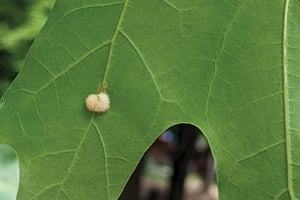
The diversity of galls is staggering, and once you notice a few, you will spot them on just about every tree and plant you see. The next time you find yourself on an autumn stroll, take a closer look under a leaf or at a stem. That oddly shaped colorful bump you see may very well be hiding an insect.